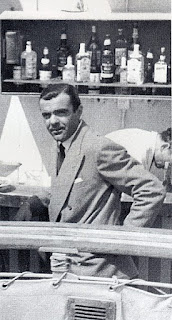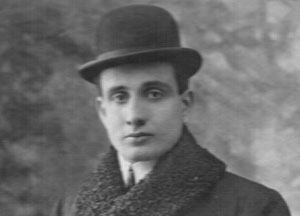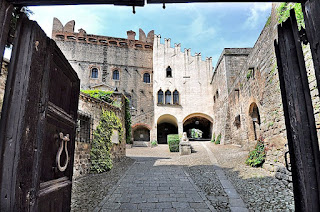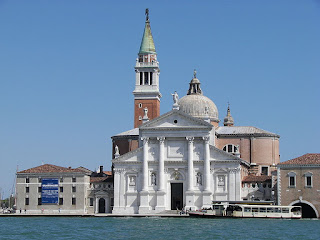Name lives on in cultural life of Venice
Giorgio Cini, the man whose name was given to a major cultural institution on the island of San Giorgio Maggiore in Venice was born on this day in 1918 in Rome.
Giorgio Cini was born into
a wealthy family
The eldest child of Vittorio Cini, who in the early 20th century was one of Italy’s wealthiest industrialists, and the celebrated silent movie actress Lyda Borelli, Giorgio took on an entrepreneurial role in his father’s businesses, which encompassed a broad range of interests, in the financial and insurance sector, steel and electrical, maritime and tourism.
Vittorio was born in Ferrara, owned a castle in Monselice near Padua, but adopted Venice as his home and devoted much of his energy to enhancing the wealth of the city. A key figure in the development of the port of Marghera, he was a close friend and business partner of Giuseppe Volpi, the businessman and politician who founded the Venice Film Festival.
Giorgio’s life was tragically cut short when he was killed in a plane crash in 1949 at the age of just 30, shortly after taking off from the small airport of Saint-Cassien near Cannes, where he had been with his fiancee, the American-born actress Merle Oberon. He had just been handed the controls by the pilot of the twin-engined aircraft when it came down.
Vittorio was plunged into grief at the sudden loss of his son, not least because he owed his life to Giorgio’s heroism during World War Two.
A politician as well as a businessman, Vittorio joined Mussolini’s Fascist party in the 1930s. He was appointed minister of communications in February 1943 but resigned after six months, one of several members of Mussolini’s cabinet who had implored the dictator to find a way to withdraw from a war that was having disastrous consequences for Italy.
 |
| Vittorio Cini was one of Italy's richest men in the early part of the 20th century |
With his father’s fate unknown, Giorgio took it upon himself to try to help him escape. Armed with a substantial sum of money from the sale of his mother’s jewellery, he managed to make his way successfully to Dachau, despite the dangers of undertaking such a journey. His father had been moved to a hospital wing, where Giorgio bribed the staff to release his father.
The two then travelled the 200km (124 miles) or so to the safety of neutral Switzerland, where they remained until it was safe to return to Italy. While in exile, Vittorio provided substantial financial support to the Italian Resistance movement in their operations against the Nazis and the Fascist stronghold in the north of Italy.
With Giorgio’s death, Vittorio decided to devote himself to philanthropy in the name of his son.
 |
| The Cini family also gave Venice the former Palazzo Foscari |
He restored the convent and repurposed it as a centre for Venetian culture. It now houses a library containing around 15,000 historical volumes, as well as an archive of manuscripts and documents about history, music, theatre and art. It also serves as a venue for exhibitions, concerts and meetings.
As well as the Foundation, the Cini family have also given Venice the Palazzo Foscari on the Grand Canal, which was Vittorio’s Venice home until his death in 1977.
The palace - now the Palazzo Cini - was donated to the Foundation in 1984 by Vittorio’s daughter, Yana, to house her father’s personal collection of Tuscan paintings and decorative arts, and to offer a space for exhibitions in conjunction with the Venice Biennale.
Both Vittorio and Giorgio are buried with other family members in the family tomb within the monumental cemetery of the Certosa di Ferrara.
Travel tip:
The Castello Monselice was painstakingly
restored by Vittorio Cini in the 1930s
The Castello Monselice, at the town of Monselice, about 25km (15 miles) south of Padua, expanded over several hundred years. The oldest part is the Casa Romantica, built in the 11th century, to which was added the Castelletto in the 12th century. During the 13th century, the Torre Ezzelino was erected and in the 15th century, after it had been acquired by the Marcello family of Venice, the Ca’ Marcello was built as a connecting building to link the defensive tower with the main building. An elegant library and a Venetian courtyard were added in subsequent centuries but the complex suffered during the First World War, when it was used by the Royal Italian Army and left in a poor state. Vittorio Cini inherited it from his family in 1935 and set about its restoration, a seven-year project in which he took care with the use of furnishings and decoration to be faithful to period detail. Still named the Castello Cini, but now owned by the Veneto region, it now offers visitors a number of guided tours each day.
Travel tip:
The white marble facade of the church of San
Giorgio Maggiore is a familiar sight in Venice
Andrea Palladio’s church of San Giorgio Maggiore is a 16th-century Benedictine church built between 1566 and 1610. Constructed in classical Renaissance style, the basilica’s brilliant white marble facade is visible directly across the Venetian lagoon from the Piazzetta di San Marco and its presence draws the eye from every part of the Riva degli Schiavoni. When Palladio arrived in Venice in 1560, the site was occupied by a Benedictine church and monastery that had been rebuilt following an earthquake in the 13th century. The architect, whose work in Venice also includes the Chiesa del Santissimo Redentore on the Giudecca island, died in 1580 and so did not live to see San Giorgio Maggiore completed, although his successors in the project kept faithfully to his designs.
Also on this day:
1908: The birth of businessman Charles Forte
1940: The birth of mathematician Enrico Bombieri
1949: The birth of politician and businesswoman Letizia Moratti
1963: The death of popular soprano Amelita Galli-Curci


.jpg)
.png)

.jpg)


%20(2).jpg)

2.jpg)


